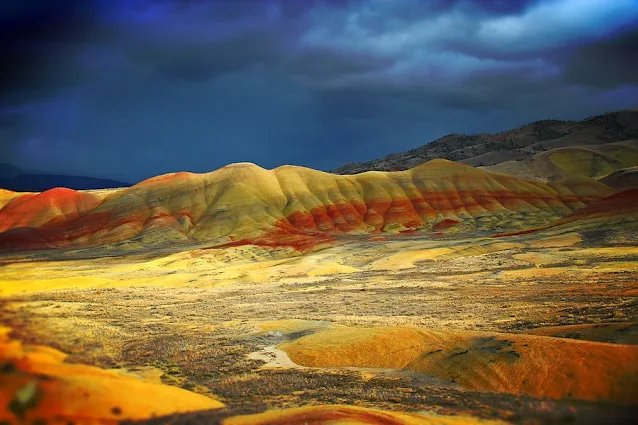The Painted Hills of Oregon
Oregon’s Painted Hills, within the John Day Fossil Beds National Monument, are a significant geological formation in central Oregon’s high desert. Characterized by stratified layers of red, yellow, gold, and black, these hills represent a 35-million-year record of volcanic, climatic, and environmental processes from the late Eocene to early Oligocene epochs. This article details their geological formation, fossil content, environmental context, and scientific importance.
Geological Formation
The Painted Hills are composed of stratified volcanic ash and clay-rich soils deposited during the late Eocene to early Oligocene epochs (approximately 39–33 million years ago). The layers originated from volcanic eruptions in the ancestral Cascade Range, which blanketed the region with ash. Over time, weathering and chemical processes altered the ash into colorful claystones and soils.
- Red layers: Iron oxides (hematite) indicate oxidized, dry conditions.
- Yellow/gold layers: Iron-rich minerals like goethite suggest wetter, less oxidized environments.
- Black/gray layers: Organic carbon or manganese oxides point to swampy, vegetated settings.
- White layers: Volcanic ash or diatomaceous earth from ancient lakebeds.
These layers were shaped by tectonic activity, erosion, and climate shifts. The region transitioned from subtropical forests to open savannas, as evidenced by fossils found nearby. Erosion has sculpted the hills into smooth, rounded shapes, exposing the colorful stratigraphy.
 |
| Stratified red, yellow, and gold claystone layers of Oregon’s Painted Hills under a clear sky, showcasing 35-million-year-old volcanic ash deposits in the John Day Fossil Beds National Monument. |
Geological Formation
The hills are composed of stratified layers of claystone, siltstone, and shale, with some lignite (low-grade coal) beds. Key features include:
Laterite Soils: The red bands are lateritic soils, rich in iron and aluminum, formed in warm, humid paleoclimates.
Clay Minerals: Montmorillonite and other clays dominate, absorbing water and swelling, which contributes to the hills’ smooth, rounded appearance.
Fossil-Bearing Layers: Interbedded with the colorful strata are fossil-rich zones containing plant and animal remains, offering insights into ancient ecosystems.
 |
| Stratified layers of red, yellow, and gold claystones in Oregon’s Painted Hills, John Day Fossil Beds National Monument. |
The colors of the Painted Hills are so striking they’ve been dubbed one of the “Seven Wonders of Oregon.” Their appearance changes dramatically with the time of day and weather, making them a favorite for landscape photography.




%20(1).webp)





